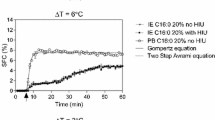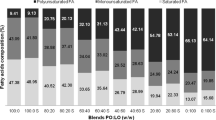Abstract
This paper explores the functionalization of mixtures of fully hydrogenated soybean oil (FHSO) and soybean oil (SO) by crystallization under specific shear and temperatures fields. FHSO was blended with SO at mass ratios of 40:60 and 45:55 and crystallized statically, under laminar shear (LS) at 30 s−1 and 240 s−1, and in a scraped surface heat exchanger (SSHE). The nano- and meso-scales were affected differently upon crystallization in a SSHE and LS cell. A decrease or no change was observed in meso-crystal sizes, meanwhile longer nano-platelets were observed after shearing. Rheological measurements demonstrated that the storage modulus (G′) and yield stress (σ*) of the fats were significantly reduced (from 35 to 90 %) after shear. Moreover, G′ and σ* of samples crystallized in a SSHE were lower than those of samples crystallized under LS; an effect related to a higher degree of crystal breakage and mechanical working. Direct and inverse relationships were observed between the mechanical properties and crystal sizes at the meso- and nano-scale respectively, suggesting a closer connection between the nano-scale and the macroscopic and functional properties of the system. Crystallization under shear induced a significant decrease in the oil binding capacity of the blends, compared to static conditions. Although we achieved mechanical properties of a functional fat material with both crystallizers; LS processing at a rate of 30 s−1 yielded more desirable oil loss values than rates of 240 s−1 and SSHE processing. Our findings demonstrate that the problem of functionalization of fully hydrogenated fats can be approached using simple shear processing.








Similar content being viewed by others
References
Acevedo, N. C., & Marangoni, A. G. (2010a). Characterization of the nanoscale in triacylglycerol crystal networks. Crystal Growth & Design, 10, 3327–3333.
Acevedo, N. C., & Marangoni, A. G. (2010b). Towards nanoscale engineering of triacylglycerol crystal networks. Crystal Growth & Design, 10, 3334–3339.
Acevedo, N. C., Block, J. M., & Marangoni, A. G. (2012a). Critical laminar shear-temperature effects on the nano- and mesoscale structure of a model fat and its relationship to oil binding and rheological properties. Faraday Discussions, 158, 171–194. doi:10.1039/C2FD20008B.
Acevedo, N. C., Block, J. M., & Marangoni, A. G. (2012b). Unsaturated emulsifier-mediated modification of the mechanical strength and oil binding capacity of a model edible fat crystallized under shear. Langmuir, 28, 16207–16217.
Andersen, A. J. C., & Williams, P. N. (1965). Margarine, 2nd revised. Oxford: Pergamon.
Brenner, H., & Condiff, D. W. (1972). Transport mechanics in systems of orientable particles III. Arbitrary particles. Journal of Colloid and Interface Science, 41, 228–274.
Campos, R., Narine, S. S., & Marangoni, A. G. (2002). Effect of cooling rate on the structure and mechanical properties of milk fat and lard. Food Research International, 35, 971–981.
Chaiseri, S., & Dimick, P. S. (1995). Dynamic crystallization of cocoa butter. II. Morphological, thermal and chemical characteristics during crystal growth. Journal of the American Oil Chemists’ Society, 72, 1497–1504.
Cohen, C., Chung, B., & Stasiak, W. (1987). Orientation and rheology of rod-like particles with weak Brownian diffusion in a 2nd-order fluid under simple shear-flow. Rheologica Acta, 26, 217–232.
Dibildox-Alvarado, E., Neves Rodrigues, J., Gioielli, L. A., Toro-Vazquez, J. F., & Marangoni, A. G. (2004). Effects of crystalline microstructure on oil migration in a semisolid fat matrix. Crystal Growth & Design, 4, 731–736.
Dirienzo, M. A., Lemke, S. L., Petersen, B. J., & Smith, K. M. (2008). Effect of substitution of high stearic low linolenic acid soybean oil for hydrogenated soybean oil on fatty acid intake. Lipids, 43, 451–456.
Erickson, D. R. (1995). Practical handbook of soybean processing and utilization. Champaign: American Oil Chemists’ Society.
European Food Safety Authority. (2004). Opinion of the scientific panel on dietetic products, nutrition and allergies on a request from the commission related to the presence of trans fatty acids in foods and the effect on human health of the consumption of trans fatty acids. The EFSA Journal, 81, 1–49.
Folch, J., Lees, M., & Sloane Stanley, G. H. (1957). A simple method for the isolation and purification of total lipids from animal tissues. The Journal of Biological Chemistry, 226, 497–509.
FSAI. (2008). Trans Fatty Acid Survey 2007 Retail Products, May. Dublin: Food Safety Authority of Ireland.
Gidding, S. S., Lichtenstein, A. H., Faith, M., et al. (2009). Implementing American heart Association pediatric and adult nutrition guidelines: a scientific statement from the American Heart Association Nutrition Committee of the Council on Nutrition, Physical Activity and Metabolism, Council on Cardiovascular Disease in the Young, Council on Arteriosclerosis, Thrombosis and Vascular Biology, Council on Cardiovascular Nursing, Council on Epidemiology and Prevention, and Council for High Blood Pressure Research. Circulation, 119, 1161–1175.
Haighton, A. J. (1959). The measurement of the hardness of margarine and fats with cone penetrometers. Journal of the American Oil Chemists’ Society, 36, 345–348.
Health Canada. (2007). Trans Fat Monitoring Program—Data Tables for the First Set of Monitoring Data, Minister of Health, Canada. Available at: www.hc-sc.gc.ca/fn-an/nutrition/gras-trans-fats/tfa-age_e.html.
Herrera, M. L., & Hartel, R. W. (2000). Effect of processing conditions on crystallization kinetics of a milk fat model system. Journal of the American Oil Chemists’ Society, 77, 1177–1187.
Hunter, J. E. (2005). Dietary levels of trans-fatty acids: basis for health concerns and industry efforts to limit use. Nutrition Research, 25, 499–513.
Institute of Medicine. (2002). Dietary reference intakes for energy, carbohydrate, fiber, fat, fatty acids, cholesterol, protein and amino acids. Washington: National Academies Press.
Jeyarani, T., & Reddy, S. Y. (2003). Preparation of plastic fats with zero trans FA from palm oil. Journal of the American Oil Chemists’ Society, 80, 1107–1113.
Larson, R. G. (1999). The structure and rheology of complex fluids. Oxford: Oxford Univ. Press.
Lee, J. H., Akoh, C. C., & Lee, K. T. (2008). Physical properties of trans free bakery shortening produced by lipase-catalyzed interesterification. Journal of the American Oil Chemists’ Society, 85, 1–11.
Liang, B., Shi, Y., & Hartel, R. W. (2008). Correlation of rheological and microstructural properties in a model lipid system. Journal of the American Oil Chemists’ Society, 85, 397–404.
List, R., Mounts, T., Orthoefer, F., & Neff, W. E. (1995). Margarine and shortening oils by interesterification of liquid and trisaturated triglycerides. Journal of the American Oil Chemists’ Society, 72, 379–382.
Litwinenko, J. W., Rojas, A. M., Gerschenson, L. N., & Marangoni, A. G. (2002). Journal of the American Oil Chemists’ Society, 79, 647–654.
Maleky, F., & Marangoni, A. G. (2008). Process development for continuous crystallization of fat under laminar shear. Journal of Food Engineering, 89(4), 399–407.
Maleky, F., Smith, A., & Marangoni, A. G. (2011). Laminar shear effects on crystalline alignments and nanostructure of a triacylglycerol crystal network. Crystal Growth & Design, 11, 2335–2345.
Manley, D. J. (1983). Technology of biscuits, crackers and cookies (pp. 61–79). Chichester: Ellis Horwood.
Maragoni, A. G., & Rogers, M. A. (2003). Structural basis for the yield stress in plastic disperse systems. Applied Physics Letters, 82, 3239–3241.
Marangoni, A. G., & Narine, S. S. (2002). Identifying key structural indicators of mechanical strength in networks of fat crystals. Food Research International, 35, 957–969.
Martini, S., Herrera, M. L., & Hartel, R. W. (2002). Effect of cooling rate on crystallization behavior of milk fat fraction/sunflower oil blend. Journal of the American Oil Chemists’ Society, 79, 1055–1062.
Mazzanti, G., Guthrie, S. E., Sirota, E. B., Marangoni, A. G., & Idziak, S. H. J. (2003). Orientation and phase transitions of fat crystals under shear. Crystal Growth & Design, 3, 721–725.
Mazzanti, G., Guthrie, S. E., Sirota, E. B., Marangoni, A. G., & Idziak, S. H. J. (2004). Novel shear-induced phases in cocoa butter. Crystal Growth & Design, 4(3), 409–411.
Mojet, J., & Koster, E. P. (2005). Sensory memory and food texture. Food Quality and Preference., 16, 251–266.
Morin-Audebrand, L. (2009). Memory test versus discrimination test: which is the best to predict consumer feed-back?. In: European Sensory Network-Workshop: Characteristics of memory for foods: Consequences for Sensory and Consumer Science, 8th Pangborn Sensory Science Symposium. Florence, Italy.
Narine, S. S., & Marangoni, A. G. (1999). Relating structure of fat crystal networks to mechanical properties: a review. Food Research International, 32, 227–248.
O’Brien, R. D. (2004). Fats and oils—formulating and processing for applications. New York: CRC Press.
Omonov, T. S., Bouzidi, L., & Narine, S. S. (2010). Quantification of oil binding capacity of structuring fats: a novel method and its application. Chemistry and Physics of Lipids, 163, 728–740.
Paulicka, F. R. (1989). Shortening products. In: Erickson (ed.) World conference on edible fats and oils proceeding- Basic principles and modern practices, pp. 203–302. Maastricht, The Netherlands.
Perez-Martinez, D., Alvarez-Salas, C., Charo-Alonzo, M., Dibildox-Alvarado, E., & Toro-Vazquez, J. F. (2007). The cooling rate effect on the microstructure and rheological properties of blends of cocoa butter with vegetable oils. Food Research International, 40, 47–62.
Perrin, F. (1934). Mouvement brownien d’un ellipsoide - I Dispersion diélectrique pour des molécules ellipsoidales. Journal de Physique et le Radium, 5(10), 499–511.
Piska, I., Zarubova, M., Louzˇecky, T., Karami, H., & Filip, V. (2006). Properties and crystallization of fat blends. Journal of Food Engineering, 77, 433–438.
Rao, R., & Lokesh, B. R. (2003). TG containing stearic acid, synthesized from coconut oil, exhibit lipidemic effects in rats similar to those of cocoa butter. Lipids, 38, 913–918.
Ribeiro, A. P. B., Grimaldi, R., Gioielli, L. A., & Gonçalves, L. A. G. (2009). Thermal behavior, microstructure, polymorphism, and crystallization properties of zero trans fats from soybean oil and fully hydrogenated soybean oil. Food Research International, 42, 401–410.
Rousseau, D., Forestiere, K., Hill, A. R., & Marangoni, A. G. (1996). Restructuring butterfat through blending and chemical interesterification 1 Melting behavior and triacylglycerol modifications. Journal of the American Oil Chemists’ Society, 73, 963–972.
Sonwai, S., & Mackley, M. R. (2006). The effect of shear on the crystallization of cocoa butter. Journal of the American Oil Chemists’ Society, 83, 583–596.
Stapley, A. G. F., Tewkesbury, H., & Fryer, P. J. (1999). The effects of shear and temperature history on the crystallization of chocolate. Journal of the American Oil Chemists’ Society, 76(6), 677–685.
Tang, D., & Marangoni, A. G. (2006). Quantitative study on the microstructure of colloidal fat crystal networks and fractal dimensions. Advances in Colloid and Interface Science, 128–130, 257–65.
Trans Fat Task Force. (2006). TRANSforming the Food Supply—Report of the Trans Fat Task Force. Minister of Health 2006, Canada. Available at: www.healthcanada.ca/transfat.
Van Aken, G. A., & Visser, K. A. (2000). Firmness and crystallization of milk fat in relation to processing conditions. Journal of Dairy Science, 83(9), 1919–1932.
West, A. R. (1984). Solid state chemistry and its applications. Chichester, West Sussex: Wiley.
Who. (2003). Diet, nutrition and the prevention of chronic diseases. WHO Technical Series Report 916, Geneva, Switzerland.
Acknowledgments
The authors acknowledge The Natural Sciences and Engineering Research Council of Canada and Advanced Foods and Materials network for the financial support. We also wish to thank Professor David Ma (Department of Human Health and Nutritional Sciences, University of Guelph) for his analysis of the fatty acid composition of the oil mixtures.
Author information
Authors and Affiliations
Corresponding author
Rights and permissions
About this article
Cite this article
Acevedo, N.C., Marangoni, A.G. Functionalization of Non-interesterified Mixtures of Fully Hydrogenated Fats Using Shear Processing. Food Bioprocess Technol 7, 575–587 (2014). https://doi.org/10.1007/s11947-013-1110-z
Received:
Accepted:
Published:
Issue Date:
DOI: https://doi.org/10.1007/s11947-013-1110-z




